Florida is the "land of flowers." Surely, one of the things that Florida is known for is the beauty of its vegetation. Due to the tropical and subtropical environment, color can abound in Florida landscapes year-round. Unfortunately, plants are not the only organisms that enjoy the mild climate. Due to warm temperatures, sandy soil, and humidity, Florida has more than its fair share of pests and pathogens that attack bedding plants. Plant-parasitic nematodes (Figure 1) can be among the most damaging and hard-to-control of these organisms.
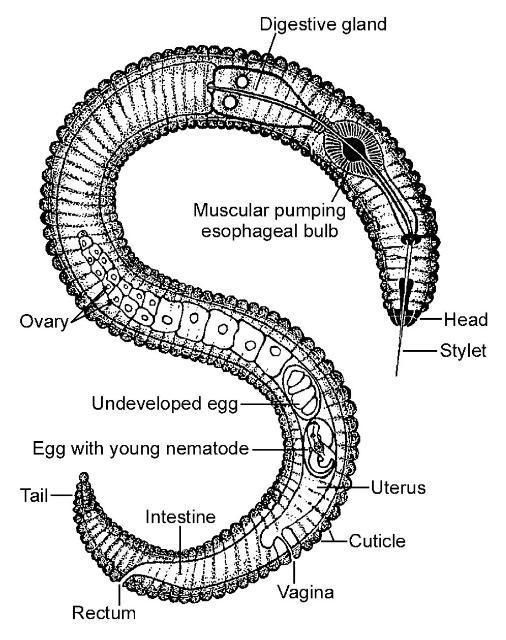
Credit: UF/IFAS
What are nematodes?
Nematodes are unsegmented roundworms, different from earthworms (https://edis.ifas.ufl.edu/in946) and other familiar worms that are segmented (annelids) or in some cases flattened and slimy (flatworms). Many kinds of nematodes may be found in the soil of any landscape. Most are beneficial, feeding on bacteria, fungi, or other microscopic organisms, and some may be used as biological control organisms to help manage important insect pests. Plant-parasitic nematodes are nematodes that feed on live plants (Figure 1).
Plant-parasitic nematodes are very small, and most can only be seen using a microscope (Figure 2). All plant-parasitic nematodes have a stylet or mouth-spear that is similar in structure and function to a hypodermic needle (Figure 3). The stylet is used to puncture plant cells and then inject digestive juices and ingest plant fluids. Most of the plant-parasitic nematodes that are important on ornamental plants in Florida feed on roots. Some plant-parasitic nematodes, called ectoparasites, remain in the soil and feed by inserting only their stylet into the root. Other nematodes enter the plant with part or all of their body and are called endoparasites. Some endoparasites, called migratory endoparasites, continually burrow around inside the root (Figure 4). Other endoparasites, called sedentary endoparasites, establish permanent feeding sites inside the root and remain in one place. As it matures, a sedentary endoparasite's body changes shape and adult females are usually swollen (Figure 5).
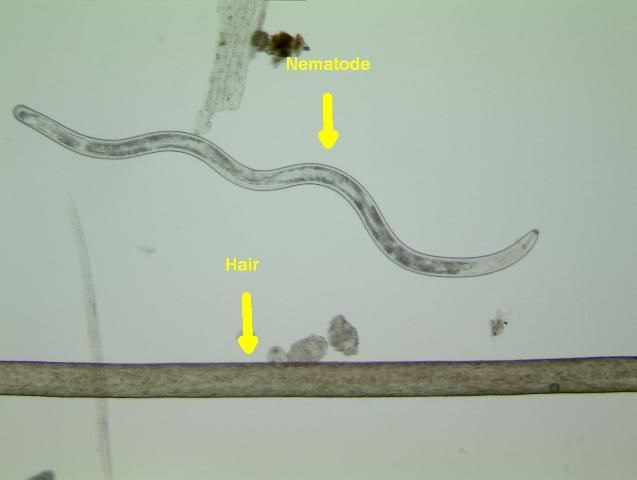
Credit: UF/IFAS

Credit: UF/IFAS
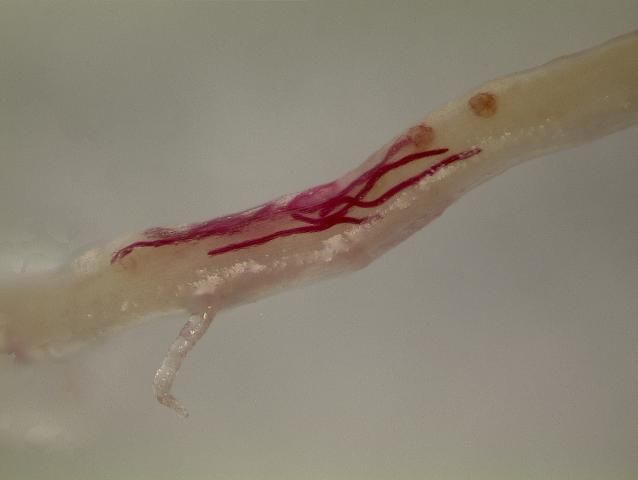
Credit: UF/IFAS
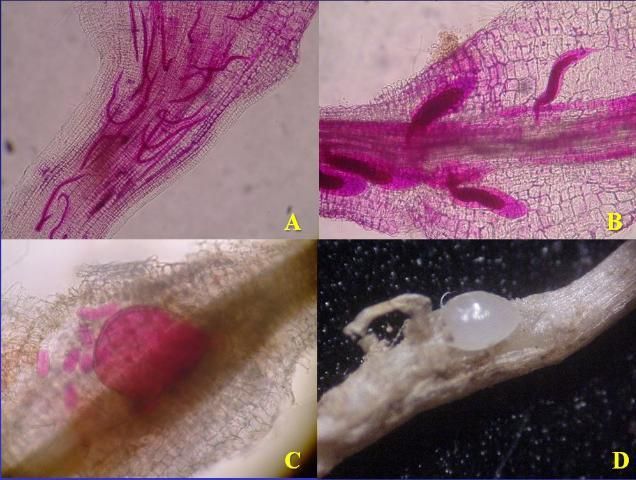
Credit: UF/IFAS
How do nematodes damage plants?
As plant-parasitic nematodes feed, they damage a plant's root system and reduce its ability to obtain water and nutrients from the soil. When nematode numbers increase, and/or when environmental stresses occur, aboveground symptoms may become evident. Aboveground nematode symptoms often resemble nutrient deficiencies or drought stress. Symptoms include yellowing, wilting, thinning, and stunting (Figure 6). These symptoms occur because the damaged roots cannot take up water and nutrients from the soil properly. If planted into beds that already have high numbers of plant-parasitic nematodes, plants may become stunted and slowly die. Nematode damage usually occurs in localized areas that may enlarge slowly over time. While other types of nematodes may damage bedding plants on occasion, in Florida the most common are root-knot, sting, awl, and stubby-root nematodes. Be aware that similar conditions may be caused by other factors such as localized soil conditions, fungal diseases, or insects.
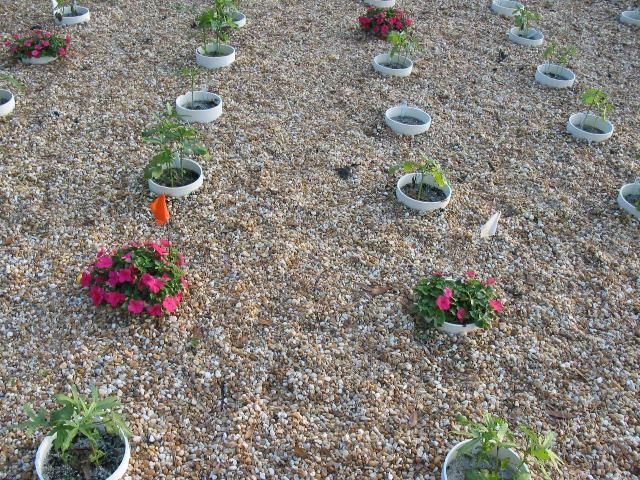
Credit: UF/IFAS
Root-Knot Nematodes
Root-knot nematodes are the most well-known of the plant-parasitic nematodes. These are sedentary endoparasites. Although other species are known to occur, four species are common in Florida on bedding plants: Meloidogyne incognita, M. arenaria, M. javanica, and M. enterolobii. These nematodes inject hormones into plants' roots that cause knots or galls to form (Figure 7). These galls are typically easy to recognize. In addition to galls, root-knot nematodes cause other physical and physiological changes in the plant. These changes can make plants more prone to fungal and bacterial plant diseases such as root rot or vascular wilt. Sometimes the damage caused by the nematodes and the other organisms together is worse than that caused by both organisms separately.
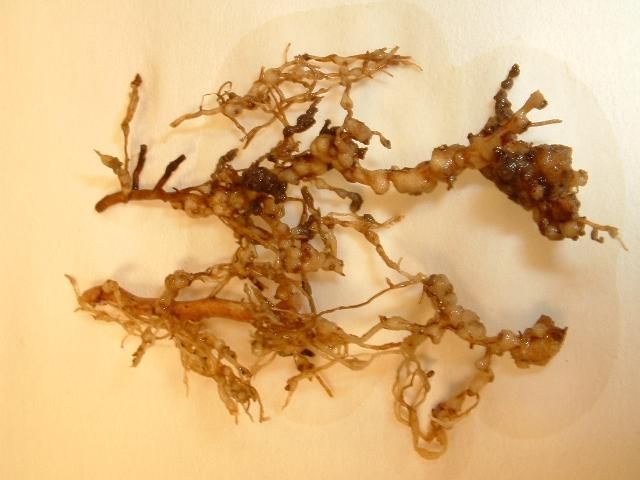
Credit: UF/IFAS
Root-knot nematodes are one of the most destructive plant parasites. High infestations can kill many types of bedding plants. Table 1 lists some of the annual bedding plants common in Florida, and their susceptibility to several species of root-knot nematodes. This is not an exhaustive list; the majority of plants may occasionally be affected by root-knot nematodes. Different cultivars of the same plant species may react differently to the nematodes. Table 2 shows the reactions of several different cultivars of Vinca (periwinkle), and Salvia to several species of root-knot nematodes.
Sting, Awl, and Stubby-Root Nematodes
Several ectoparasitic nematodes are capable of causing damage to bedding plants in Florida. The most destructive of these are the sting (https://edis.ifas.ufl.edu/in395), awl (https://edis.ifas.ufl.edu/in397), and stubby-root (https://edis.ifas.ufl.edu/in617) nematodes. Feeding by these nematodes usually causes roots to be stunted or stubby-looking (Figure 8). All of these nematodes are capable of destroying a plant root system, causing stunting and wilting, or killing the plants. Sting nematodes are found in sandy soil and are common throughout much of Florida. Awl nematodes are usually found in wet habitats, for instance, near ditches, ponds, or poorly drained areas. Several stubby-root species are found in Florida. One or more can usually be found in most Florida habitats.
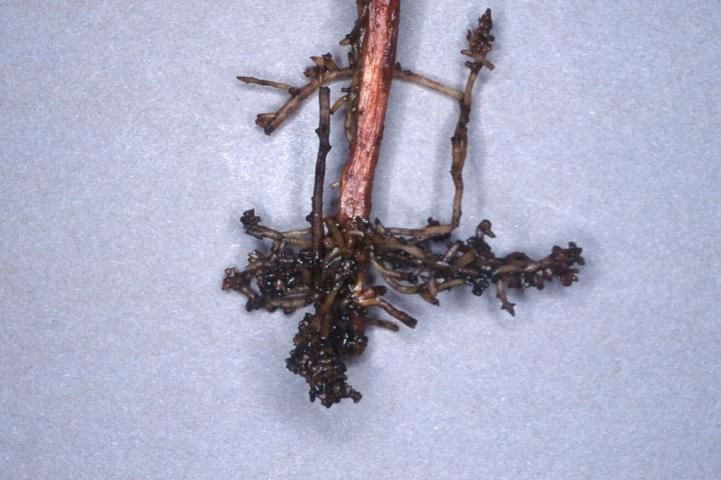
Credit: UF/IFAS
How do I know if nematodes are my plants' problem?
With any plant problem, having an accurate diagnosis is important to address the problem, and to avoid wasting effort and unnecessary pesticide applications. Generally, nematode symptoms resemble the symptoms of other disorders, so visual inspection is not enough. The only reliable way to determine if plant-parasitic nematodes are causing or contributing to a plant problem is to have a nematode assay conducted by a professional nematode diagnostic lab. The UF/IFAS Florida Nematode Assay Lab, will evaluate nematode samples for a cost of $20.00 each. See the Florida Nematode Assay Lab website at https://entnemdept.ufl.edu/nematology-assay-lab/ for information on forms, fees, and sample submission. The lab staff will assign a level of risk to the sample based on what kind of nematodes they find, how many nematodes there are, and the type and age of the plants involved. To make an accurate nematode diagnosis, the lab must have a quality sample. Whether you are submitting a sample to the Florida Assay Lab or another lab, following the guidelines below can help ensure that the results will be as accurate as possible.
Sampling
Sometimes samples are collected before planting to find out if nematodes are a potential problem and, if so, to take protective measures. Pre-plant samples will typically only consist of soil. After planting, samples are collected from sick plants to determine if nematodes are the cause of plant decline. Samples taken after planting require both soil and roots.
Before planting: Collect soil from 8 to 12 locations in a planting bed. Samples should be taken about 6 to 8 inches deep. If the soil is dry, dig down to where there is some soil moisture to collect the samples and do not include the dry soil. A small handful of soil from each location is adequate. Combine all the soil into a single plastic bag. The total volume of soil from the samples should be about 1 pint. Samples may be taken with a shovel, trowel, or other device. If you use a shovel, you can put part of the soil from 8 to 12 shovels full into a bucket. Thoroughly mix the soil in the bucket, and then take out a pint to submit for analysis.
After planting: Often a nematode assay is needed to determine if nematodes are causing a plant to get sick. This type of sample requires both soil and roots! Dig soil and roots from underneath the canopy of the symptomatic plants. Sample depth depends on the size of the plant. For most bedding plants, 6 inches deep is adequate. Do not include the top 1 inch of soil. If multiple plants are affected, collect some soil and roots from several plants. Place the soil and roots together in the same plastic bag. A minimum of 1 pint of soil and 1 to 2 cups of roots are required. For small bedding plants, entire plants with the soil from around their roots can be submitted.
Handling
- Nematode samples should be kept in plastic bags to keep the sample moist. Do not send samples in soil test bags. Soil testing bags are designed to dry soil out, and dried-out samples are no good for nematode diagnosis. If using a self-sealing bag, tape the seal shut so that the bag does not come open in the mail.
- If submitting more than one sample, make sure that the outside of each bag is labeled with a permanent marker. You can also write on masking tape stuck to the bag. Do not put paper labels inside of bags because they tend to decompose and become illegible.
- Keep samples out of direct sunlight or heat. Heat and ultraviolet light kill nematodes. Even a few minutes on the dashboard or in the back of a pickup can invalidate assay results. Keep the samples in an air conditioned room until they can be shipped.
- Handle the sample gently and pack it well. The more the soil gets banged around, the more the nematodes may get destroyed.
- Fill out the information on the forms with as much information as possible. The diagnostician needs detailed information about the type of plant or plants in question and the cultivar, if known. Make sure that the information on the form matches the identification on the sample bag (i.e., front yard, back yard, coleus bed).
What can I do about nematodes?
Chemicals
There are no chemical nematicides labeled for use on annual bedding plants that have been effective in University of Florida trials.
Resistance and Tolerance
Plants on which a particular nematode cannot reproduce are called resistant to that nematode. Plants that can be fed on by the nematode without damage are called tolerant. Although a great deal of work has gone into identifying nematode-resistant agronomic and vegetable crops, little work has been done with bedding plants. This is an area of research we are currently exploring at the University of Florida. For now, the plants identified as susceptible in Tables 1 and 2 should be avoided in areas where root-knot nematodes are known to occur. If you grow resistant plants but have plans to plant susceptible plants later, keep the area as weed-free as possible. If weeds are allowed to grow, the nematodes may maintain their populations by feeding on the weeds.
Marigolds are often promoted as nematode-resistant. Table 3 lists the susceptibility of a number of species and cultivars of marigold to different species of root-knot nematodes. Different types of marigolds are resistant to different species of root-knot nematodes. Few cultivars are resistant to all of them. Therefore, while marigolds may grow very well in soil infested by root-knot nematodes, there is always a possibility of nematode damage occurring.
Several cultivars of salvia appear to be resistant to at least two of the root-knot species common in Florida (Table 4). These cultivars may be useful for planting in soil infested with root-knot nematodes. Vinca (Periwinkle) is a plant that does not support populations of certain root-knot nematodes even though it may have galling (Table 4). So, once the plant gets past the initial galling, it should do well.
Soil Solarization
Soil solarization is a process of using heat from the sun to kill nematodes and other pests. The soil should be worked with a hoe or rototiller to break up clods. Remove all sticks, roots, and clumps. The soil should be moist, but not wet. Cover the soil with a clear plastic tarp and bury the edges of the plastic (Figure 9). Leave the plastic on the soil for at least 4 to 6 weeks. Do not remove the plastic until you are ready to plant.
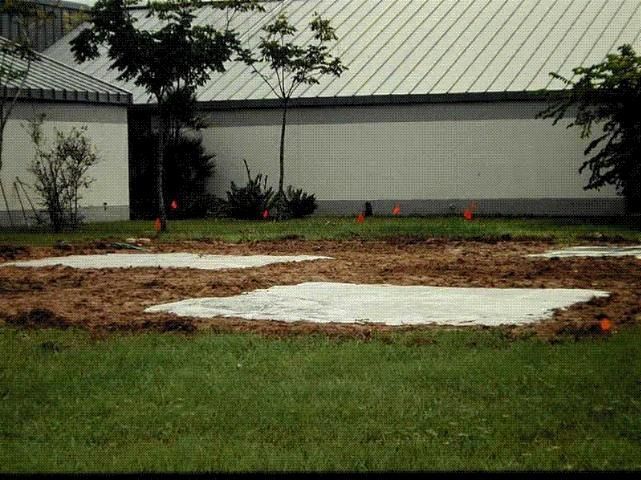
Credit: UF/IFAS
Sunlight goes through the clear plastic and heats the soil underneath. The plastic then holds in the heat so that it penetrates and warms the soil. Long-term exposure to high temperature kills nematodes, as well as many weeds, fungi, and insect pests. The disinfested zone is usually 6 to 8 inches deep. Do not till or mix the soil after solarization. That may reinfest the soil you just solarized with nematodes from below the treated zone. Because it depends on sunlight and heat, solarization works best during the summer months. It does not work well in areas that get shade. Only solarize planting beds that get full sun.
The benefits of solarization may be enhanced by using a second layer of plastic suspended by wire hoops. An air gap is created between the two layers of plastic, giving extra insulation. Also, weeds that penetrate the first layer may then be killed by heat trapped between the plastic layers.
Organic Amendments
Organic amendments can be added to soil as compost, manure, green manure, or other materials (https://edis.ifas.ufl.edu/vh037). Organic matter can help prevent nematode damage in several ways. The organic matter increases the ability of the soil to hold water and nutrients, and it improves soil structure. This makes a better environment for most plants and can help the plants survive in spite of the nematodes. Organic amendments can also increase natural enemies of nematodes that suppress the nematode populations. Some organic amendments can release chemicals or gasses that are toxic to the nematodes.
There are several "organic" nematode management products for sale. Researchers with the University of Florida have worked with a number of these, but probably not all of them. UF research has found Comand® compost to be suppressive to some kinds of plant-parasitic nematodes if incorporated into soil before planting.
Planting
Nematode activity slows as soil temperatures drop. Therefore, annual plants grown in cooler months do not suffer as much from nematodes as those grown in warmer months. Become familiar with the temperature requirements of the plant and grow as early as possible in the spring or as late as possible in the fall.
Older transplants generally are more resistant to nematodes than younger transplants. So, older transplants should be used in nematode-infested soil. Inspect the roots of all landscape plants before purchase for root-knot galls or other root-related problems. Occasionally nematodes can be introduced with contaminated plants.
Sanitation
Roots left in the soil can continue to live and support nematode reproduction. Root-knot nematode eggs are attached to roots and will continue to hatch even after the plant appears to be dead. Therefore, as soon as it is clear that a plant is dying, it is best to pull it up. Make sure to dig up as many roots as possible and destroy them.
Be aware that when soil is moved, pathogens can be moved with it. After digging up sick plants, make sure that any shovels or other equipment are thoroughly cleaned to avoid moving nematodes and plant pathogens to new areas.
Remove Infested Soil
In annual planting beds, it is sometimes practical to replace infested soil and start over. Nematodes may re-infest the soil later, but by then the plants should have a good root system established. The better developed the root system is, the more tolerant the plant will be to nematodes. The benefits of replacing soil may only last a season or two.
Container Growing
Growing plants in containers off the ground is a way to avoid nematode problems. Make sure you inspect the plants for root-knot galls. You don't want to introduce a problem. Also use clean potting media. Do not mix potting media with native soil because you might contaminate it.
Summary
Following the recommendations listed in this document can help you avoid or reduce problems with plant-parasitic nematodes in the landscape. However, there are no guarantees of success. County and state faculty with the University of Florida are continually exploring new nematode management options. The most current recommendations can be obtained from the UF/IFAS Extension website at https://solutionsforyourlife.ifas.ufl.edu/.
Table 1. Root galling and reproduction of root-knot nematodes on 12 annual ornamental species.1 Columns show reactions of each plant species to a root-knot nematode population in work done by C. C. Goff in the 1930s (more plants are listed in Table 2), common root-knot nematode (Meloidogyne incognita), javanese root-knot nematode (M. javanica), and "peanut" root-knot nematode (M. arenaria).
Table 2. Susceptibility of some annual ornamental plants to root-knot nematodes in Central Florida.*
Table 3. Galling and reproduction of root-knot nematodes on several common cultivars of Salvia and Vinca.
Table 4. Marigold species and varieties differ in their usefulness in managing root-knot nematodes.1